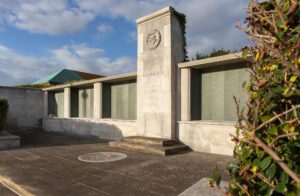Hampshire has a rich military history spanning across the centuries and among all three elements that make up the modern-day British Armed Forces. In this blog, Public Engagement Coordinators for the Commonwealth War Graves Commission Will Reid and Megan Kelleher highlight some of the sites that you can visit in Hampshire that remember the war dead from the two World Wars.
As many people know, Hampshire’s military history spans across the generations. From its longstanding connection to the Royal Navy, to the modern-day Royal Air Force (RAF) stations that are across the county, the county’s role in defending the nation is longstanding. Consequently, there are numerous locations across the county where individuals who died during the two World Wars are commemorated. In Hampshire, there are over 39,000 individuals commemorated at more than 332 locations by the Commonwealth War Graves Commission (CWGC). In this blog, we are going to highlight why they are here and some of the stories that individuals can learn by visiting these locations.
Firstly, it is important to highlight who the CWGC is. The organisation now known as the Commonwealth War Graves Commission is the organisation tasked with the commemoration and care of the war dead from the British Empire who lost their lives during the two World Wars. Their work covers over 23,000 locations in more than 150 countries and territories worldwide, and they care for an estimated 1.7 million individuals.
When many individuals think of the work of the Commission and their personal interactions with it, they may be drawn to considering the battlefields of the former Western Front or perhaps further afield. While these sites of memory are important to our understanding of British commemorative practices relating to the two World Wars, they do not represent the full picture. Indeed, there are more than 306,000 commemorations at more than 13,000 sites in the United Kingdom and Ireland. This means that there are in fact more commemorations here than there are in Belgium, and the United Kingdom and Ireland have the second highest number of commemorations by the Commission; first is France, then Britain.
So, why are individuals commemorated in Britain by the CWGC? There are a number of reasons; these include, but are not limited to:
- Having been injured or become ill overseas, they were sent back to Britain where they later died of their wounds or illness.
- They died during training accidents that were occurring in Britain.
- They died in accidents more generally, such as whilst on leave.
- They were killed in the air or at sea, with their remains either lost and therefore being commemorated on a memorial, or their remains were later washed ashore.
We can see examples of each of these types of cases within the stories found in Hampshire, which once again emphasises its importance to British military history.

Many people may pass by this memorial on Southsea Common, but did you know what it represents? The Portsmouth Naval Memorial commemorates over 24,000 service personnel who have no known grave except the sea, and it is one of the three identically-designed memorials to the missing for naval dead from the two World Wars in Britain; the other two are at Plymouth and Chatham, the other key manning ports from this time. This memorial was unveiled in 1924 by the then-Duke of York, who later became HRH King George VI.This unveiling was covered extensively in the Hampshire Telegraph and Post at the time, who highlighted that between nine and ten thousand tickets had been issued by naval authorities to participate in the unveiling, with more members of the public attending and watching the ceremony from nearby vantage points.[1]

Among those remembered here include some of the individuals who lost their lives in the Battle of Jutland in 1916, as well as HMS Hood which was sunk by the German battleship Bismarck and cruiser Prinz Eugen at the Battle of Denmark Strait in May 1941.[2]
Lee-On-Solent Memorial
This memorial commemorates over 1,900 service personnel of the Fleet Air Arm who lost their lives during their Second World War in theatres across the globe. These individuals flew fighters, torpedo bombers and reconnaissance aircraft, supporting the Royal Navy and Merchant Navy in almost every theatre of the Second World War.

Among those remembered here is 23-year-old 3rd Officer Thelma Daphne Jackson of the Women’s Royal Naval Service, who is the only woman commemorated on the memorial. She was killed in the same incident that took the life of her husband, 22-year-old Sub-Lieutenant Arthur Myles Jackson, and Sub-Lieutenant Eric Fretwell. On 23rd July 1944, all three took off from Perranporth in Cornwall; they were in a Swordfish torpedo bomber, which was being piloted by Sub-Lieutenant Fretwell. Although the exact circumstances of their deaths are not known, and the wreckage was never located, it is likely that they crashed into the sea due to mechanical trouble.

Hollybrook Memorial
Located in Southampton, this site commemorates almost 1000 service personnel from both the Army and Air Forces who died in seas around the United Kingdom during the First World War and who have no known grave.

One of the most famous casualties remembered here is Field Marshal Lord Herbert Kitchener, who was Secretary of State for War. Arguably most famous for his “Your Country Needs You” recruitment poster from the time, Field Marshal Lord Kitchener died when the battle cruiser HMS Hampshire was mined and sunk off Scapa Flow in June 1916.
Men of the South African Native Labour Corps are also commemorated on Hollybrook Memorial in Southampton. The vast majority tragically perished when their transport ship SS Mendi collided with another in thick fog whilst enroute for Le Havre. CWGC’s Hollybrook Memorial to the Missing is inscribed with the names of over 600 men of SANLC that lost their lives on SS Mendi, who have no known grave.
We hope that this blog piece has given you a flavour of just some of the sites you can visit across Hampshire that are cared for in perpetuity by the CWGC. There are thousands of stories that you can uncover in your local area, and we often share some of these through our free guided tours of some of the sites. To find out more about the work of the CWGC, please visit our “Our War Graves, Your History” webpage.
[1] For more information, visit: https://www.cwgc.org/our-war-graves-your-history/explore-great-britain/south-region/portsmouth-naval-memorial/
[2] Hampshire Telegraph and Post, 17th October 1924 (from the British Newspaper Archive).
Authors:
Megan Kelleher

Bio:
Megan the Public Engagement Cooridnator for the East (Central) region of England for the
Commonwealth War Graves Commission. She is also a PhD student at the University of
Kent and the British Association for Local History’s Social Media Fellow. Her thesis,
provisionally titled ‘The Commemoration and Care of First World War Dead Buried in the
United Kingdom’, is focused on highlighting the presence of First World War graves in the
United Kingdom and how these sites of memory conform to and contrast with the cemeteries and memorials found along the former battlefields.
Twitter: @MeganEKelleher
Email: megan.kelleher@cwgc.org
Will Reid

Bio:
Will is the Public Engagement Coordinator for the South Region of England for the
Commonwealth War Graves Commission. He studied an undergraduate degree in
Archaeology and a master’s degree in Cultural Heritage and Resource Management
at Winchester University. During his studies he specialised in conflict archaeology
and has subsequently been involved with numerous archaeological projects
uncovering the very history he spends much of his time speaking about on tours and
events with the CWGC.
Twitter: @TrowelBoy123
Email: will.reid@cwgc.org

